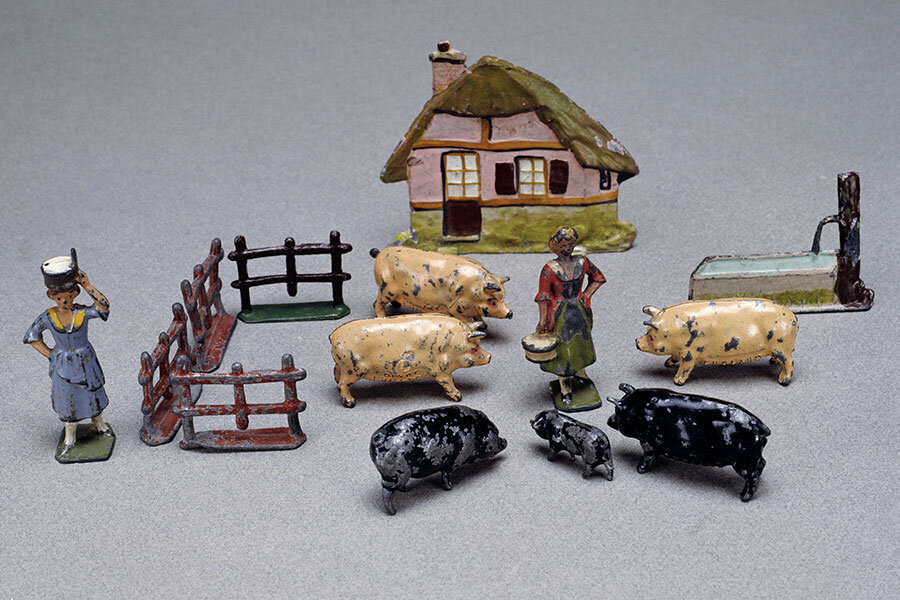How a toy farm bridged my worlds
Loading...
The sign was hand-painted: Fairview Farm. The driveway ran between green fields, ending at a thatched cottage beneath a spreading tree made of a nicely branched twig with bits of green sponge for foliage. Beyond the cottage, lead horses in stalls stood knee-deep in dried grass clippings; cows gazed steadily at mangers filled with Quaker Oats. Beside a pen full of sheep, two patient collies waited with the shepherd, whose one movable arm held a crook. The entire rural enterprise existed on a table covered in green oilcloth.
Fairview Farm began the summer I was 9, my first summer back in England, two years after we had moved to America. Wandering into the little toy store on the market square of my grandparents’ country town, I discovered shelf upon shelf of lead animals, glossily painted and perfect in their details. There were horses of every type: delicate thoroughbreds with their long-legged foals, sturdy ponies, draft horses with rough manes and feathered fetlocks. There were cows, too, and pigs and sheep – even chickens and geese trailing lines of chicks and goslings. Another shelf held rows of familiar farm buildings: stables, cowsheds, Dutch barns.
I was enthralled. Here was a way to take the English countryside home with me. I could have, in miniature, those fields of grazing cows I rode through on the pony, the chickens whose eggs I gathered, the collies and the flocks of sheep they herded, the box stalls with their Dutch doors, over which my uncle’s thoroughbreds stretched curious noses to nibble at my hair. With that week’s pocket money, I bought two horses and a box stall.
By the time we flew back to America in August, I carried the farmer, his wife, and an assortment of animals and buildings carefully packed in my bag. When I made my way down the stairs from the plane onto an endless expanse of tarmac, the sky looked very high and empty. Missing the scudding English clouds, I hugged my bag tighter.
That was the nucleus of Fairview Farm. Each birthday and Christmas, I eagerly awaited the bulky parcels from England. My grandmother never failed me. Inside, painstakingly wrapped in thin postwar wrapping paper printed with designs of holly and robins, would be cowsheds and pigpens, henhouses and more livestock. She unerringly sent me things I didn’t have: a gray horse grazing, a blacksmith’s forge (complete with blacksmith and minuscule horseshoes), a cat in a basket with three tiny kittens, a burrow with a pair of wild brown rabbits and four rabbit babies even tinier than the kittens.
As the farm grew, so did my ambitions. I kept lists of my stock in a notebook. My sheep were Cheviots and Romneys, with a Scottish Blackface or two. I had cows (red and white Herefords and golden Guernseys) and two kinds of pigs (Saddleback, black with a white stripe around their considerable girth, and ordinary pink Yorkshires). But the thoroughbred horses were the most important. For them I had studbooks, bloodlines partly made up and partly drawn from issues of Blood-Horse magazine. They had romantic names like Evensong and Billy Blaze.
There were no motorized vehicles on my farm. The plow and the hay wagon, with its working tailgate and removable hayracks, were drawn by a stocky white horse. There was a cart for trips into town (the top of a nearby bookcase), pulled by a pony I named Polly, but no car.
Fairview Farm reproduced an agrarian world at the turn of the last century, a world retained in the molds for those lead animals long after the real mold had been broken. That world had not existed in my lifetime. No matter. For me, this was a fantasy England created as much from the books I read as from my own memories.
Gradually, as time passed and England became more and more a country of the imagination, another landscape began to superimpose itself. Trees were hung with cotton-wool Spanish moss after I read “The Yearling,” and a bow-legged plastic cowboy was ensconced in a cowshed-turned-bunkhouse when I fell in love with the California ranch of “The Red Pony.”
Fairview Farm became a way to integrate the New World into the old. From time to time, thoroughbreds became quarter horses, even a mustang or two. Rhode Island Reds roosted in the henhouse. Sugar maples took root in one field and snow (soap flakes) sometimes fell heavily.
The transformation, however, was never complete. Part of Fairview Farm remained English so that I could retain that part of myself as I adjusted to a new country. The world of the imagination has permeable boundaries; on Fairview Farm, I didn’t have to choose.







